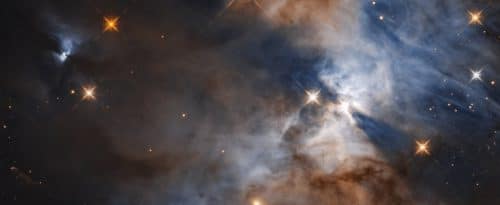
NASA/European Space Agency's Hubble Space Telescope has captured part of the Serpentine Nebula, illuminated by the star HBC 672. This young star casts an impressive shadow—known as the bat shadow—on the nebula behind it, revealing telltale signs of its otherwise invisible preplanetary disk. Other.
The Serpent Nebula, located in the tail of the Serpens Cauda at a distance of about 1,300 light years, is a return nebula that owes most of its brightness to the light emitted by stars such as HBC 672 - a young star that resides in its folds of dust. In this image, the NASA/European Space Agency Hubble Space Telescope has revealed two huge cone-like shadows emanating from HBC 672.
These large shadows on the Serpent Nebula are cast by the protoplanetary disk that orbits HBC 672. As it clings tightly to the disk star, it creates an impressive shadow, much larger than the disk—about 200 times the diameter of our solar system. The shadow of the disc is similar to the shadow produced by a lamp shade in the shape of a cylinder. Light comes from above and below, but along the perimeter of the lampshade dark cones of shadow are formed.
The grief and the shadow
The disk itself is so small and far from Earth that even Hubble cannot detect it around its host star. But the shadow feature—called the bat shadow—reveals details about the shape and quality of the disc. The existence of a shadow indicates that we see the disk almost straight in front of the rim line (edge-on). Most of the shade is completely opaque, but the scientists can look for color differences along the rim lines, where a certain amount of light passes through. Using the shape and color of the shadow, they can determine the size and composition of the dust grains in the disk.
Throughout the Serpent Nebula, of which this image shows only a tiny part, there could be more such shadow projections. The nebula envelops hundreds of young stars, many of which may also be in the process of forming planets in the protoplanetary disk. Shadow-casting discs are common around young stars, but the combination of a straight-ahead viewing angle and the circumstellar nebula is rare. But in an unlikely coincidence, a similar-looking shadow phenomenon can be seen emanating from another young star, in the upper left of the image.
These valuable insights into protoplanetary disks around young stars allow astronomers to probe our past. The planetary system we live in once emerged from a similar preplanetary disk when the Sun was only a few million years old. The study of these distant disks allows us to reveal the formation and evolution of our cosmic home.
For a report by the Space Telescope Science Center
More of the topic in Hayadan:
